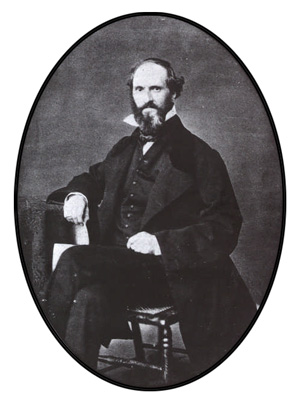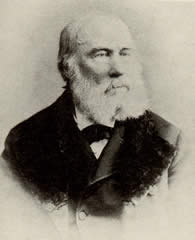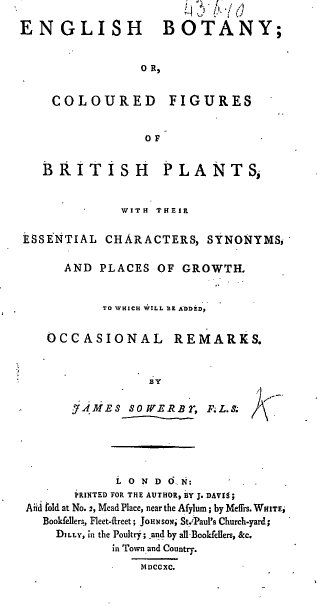Related Research Articles

George Bentham was an English botanist, described by the weed botanist Duane Isely as "the premier systematic botanist of the nineteenth century". Born into a distinguished family, he initially studied law, but had a fascination with botany from an early age, which he soon pursued, becoming president of the Linnaean Society in 1861, and a fellow of the Royal Society in 1862. He was the author of a number of important botanical works, particularly flora. He is best known for his taxonomic classification of plants in collaboration with Joseph Dalton Hooker, his Genera Plantarum (1862–1883). He died in London in 1884.

Sir William Jackson Hooker was an English botanist and botanical illustrator, who became the first director of Kew when in 1841 it was recommended to be placed under state ownership as a botanic garden. At Kew he founded the Herbarium and enlarged the gardens and arboretum. The standard author abbreviation Hook. is used to indicate this person as the author when citing a botanical name.

Richard Spruce was an English botanist specializing in bryology. One of the great Victorian botanical explorers, Spruce spent 15 years exploring the Amazon from the Andes to its mouth, and was one of the first Europeans to visit many of the places where he collected specimens. Spruce discovered and named a number of new plant species, and corresponded with some of the leading botanists of the nineteenth century.

John Lindley FRS was an English botanist, gardener and orchidologist.

Walter Hood Fitch was a botanical illustrator, born in Glasgow, Scotland, who executed some 10,000 drawings for various publications. His work in colour lithograph, including 2700 illustrations for Curtis's Botanical Magazine, produced up to 200 plates per year.

Ronald Campbell Gunn, FRS, was a South African-born Australian botanist and politician.

The Botanical Magazine; or Flower-Garden Displayed, is an illustrated publication which began in 1787. The longest running botanical magazine, it is widely referred to by the subsequent name Curtis's Botanical Magazine.

William Henry Harvey, FRS FLS was an Irish botanist and phycologist who specialised in algae.

Robert Wight MD FRS FLS was a Scottish surgeon in the East India Company, whose professional career was spent entirely in southern India, where his greatest achievements were in botany – as an economic botanist and leading taxonomist in south India. He contributed to the introduction of American cotton. As a taxonomist he described 110 new genera and 1267 new species of flowering plants. He employed Indian botanical artists to illustrate many plants collected by himself and Indian collectors he trained. Some of these illustrations were published by William Hooker in Britain, but from 1838 he published a series of illustrated works in Madras including the uncoloured, six-volume Icones Plantarum Indiae Orientalis (1838–53) and two hand-coloured, two-volume works, the Illustrations of Indian Botany (1838–50) and Spicilegium Neilgherrense (1845–51). By the time he retired from India in 1853 he had published 2464 illustrations of Indian plants. The standard author abbreviation Wight is used to indicate this person as the author when citing a botanical name.

Annals of Botany is a monthly peer-reviewed scientific journal publishing experimental, theoretical and applied papers on all aspects of plant biology. The current (2022) Chief Editor is Rowan Sage, replacing John Seymour (Pat) Heslop-Harrison. The journal is owned and managed by the Annals of Botany Company, a non-profit educational charity registered with the Charity Commission for England and Wales. It is published monthly through Oxford University Press in paper form and online, and is paid for primarily by institutional annual subscriptions. Regular extra issues, published free-of-charge, focus on topical themes. The journal does not levy page charges but authors may choose to pay a standard fee to secure open access status for their papers. According to Journal Citation Reports, in 2019 Annals of Botany’s impact factor was 4.005 and was ranked 27th out of 234 journals in the Plant Sciences category. The Journal's Eigenfactor was 0.01652, its H-Index 165 and the SCImago score 1.615. Also owned by the educational charity, Annals of Botany has two sister journals, AoB Plants, an online only open access botanical journal and in silico PLANTS, an online open access journal devoted to plant modelling. It is also closely associated with the informal online plant science publication Botany One.

English Botany was a major publication of British plants comprising a 36 volume set, issued in 267 monthly parts over 23 years from 1790 to 1814. The work was conceived, illustrated, edited and published by the botanical illustrator and natural historian, James Sowerby. The brief formal technical descriptions were mostly supplied by the founder of the Linnean Society, Sir James Edward Smith. Initially Smith had declined to have his name associated with the work as he considered that his professional co-operation with a socially inferior artisan such as Sowerby might degrade his standing in higher circles. However, following the phenomenal public success and general acceptance by the professional class of the work he insisted that the title page of the fourth and succeeding volumes credited the work to his name with Sowerby named solely as the illustrator. The work, however, continued to be generally referred to as "Sowerby's Botany". In spite of this abuse of their social class differences by Smith, the two men were good friends and happily worked together on several projects over many years. The work was printed by J. Davis, London; initially on Edmeads and Pine laid paper.

Mahonia nevinii, known by the common name Nevin's barberry, is a species of flowering shrub in the barberry family.

Dr. Robert Kaye Greville FRSE FLS LLD was an English mycologist, bryologist, and botanist. He was an accomplished artist and illustrator of natural history. In addition to art and science he was interested in causes like abolitionism, capital punishment, keeping Sunday special and the temperance movement. He has a mountain in Queensland named after him.

Senecio bahioides is a flowering plant species of the genus Senecio and family Asteraceae. It is a native of Chile.
William M. Wilson (1799–1871) was an English botanist, known for his focus on bryology.

Anna Maria Walker and her husband Colonel George Warren Walker (1778–1843) were Scottish botanists in Ceylon who made extensive collections of plants between 1830 and 1838. Several species of ferns and orchids were named after them by Sir William Jackson Hooker with whom they corresponded. They also corresponded with and collaborated with other botanists in the region such as Robert Wight. Anna Maria was also an excellent botanical artist who illustrated many species of orchids. Plant species named after them include Vanilla walkeriae, Liparis walkeriae and Thrixspermum walkeri.

The Flora Antarctica, or formally and correctly The Botany of the Antarctic Voyage of H.M. Discovery Ships Erebus and Terror in the years 1839–1843, under the Command of Captain Sir James Clark Ross, is a description of the many plants discovered on the Ross expedition, which visited islands off the coast of the Antarctic continent, with a summary of the expedition itself, written by the British botanist Joseph Dalton Hooker and published in parts between 1844 and 1859 by Reeve Brothers in London. Hooker sailed on HMS Erebus as assistant surgeon.

The Ross expedition was a voyage of scientific exploration of the Antarctic in 1839 to 1843, led by James Clark Ross, with two unusually strong warships, HMS Erebus and HMS Terror. It explored what is now called the Ross Sea and discovered the Ross Ice Shelf. On the expedition, Ross discovered the Transantarctic Mountains and the volcanoes Erebus and Terror, named after his ships. The young botanist Joseph Dalton Hooker made his name on the expedition.
Leucocoprinus zeylanicus is a species of mushroom producing fungus in the family Agaricaceae.
References
- ↑ Botanical miscellany Biodiversity Heritage Library. Retrieved 18 May 2015.